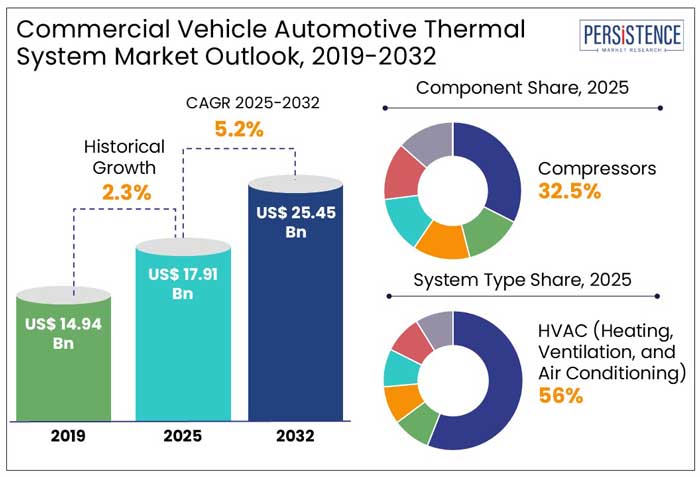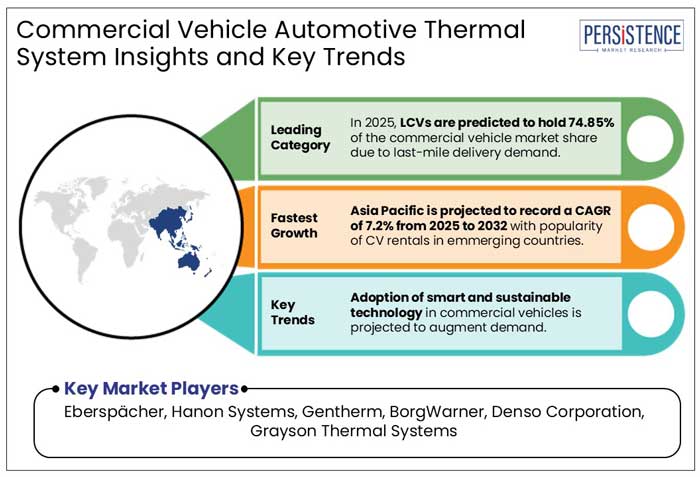Commercial Vehicle Automotive Thermal System Market
Industry: Automotive & Transportation
Published Date: February-2025
Format: PPT*, PDF, EXCEL
Delivery Timelines: Contact Sales
Number of Pages: 194
Report ID: PMRREP35131
The global commercial vehicle automotive thermal system market size is anticipated to rise from US$ 17.91 Bn in 2025 to US$ 25.45 Bn by 2032. It is projected to witness a CAGR of 5.2% from 2025 to 2032.
As per Persistence Market Research (PMR), the automotive temperature control system in commercial vehicles improves driver comfort and efficiency. The market is rising due to vehicle scrappage programs and infrastructure expansion. Leading manufacturers are envisioned to invest in next-generation cooling and heating technologies.

Key Highlights of the Commercial Vehicle Automotive Thermal System Market
|
Global Market Attributes |
Key Insights |
|
Commercial Vehicle Automotive Thermal System Market Size (2025E) |
US$ 17.91 Bn |
|
Market Value Forecast (2032F) |
US$ 25.45 Bn |
|
Projected Growth (CAGR 2025 to 2032) |
5.2% |
|
Historical Market Growth (CAGR 2019 to 2024) |
2.3% |
Decline in Trucking Sector Caused Job Losses and Reduced Demand for Automotive Thermal Systems from 2019 to 2024
The global commercial vehicle automotive thermal system industry witnessed a CAGR of 2.3% in the historical period between 2019 and 2024. The automotive sector, notably commercial vehicle automotive thermal systems, was hindered by the COVID-19 pandemic. Major delays and job losses resulted from the partial or complete closure of key factories. For example,
Automakers faced a twofold revenue crisis when the worldwide market opened in the middle of 2021 due to the construction of new BS 6 and Euro 5 models as well as prolonged client demand.
Manufacturers to Broaden Product Lines and Adopt New Technologies to Enhance Competitiveness through 2032
In the estimated timeframe from 2025 to 2032, the global market for commercial vehicle automotive thermal systems is likely to showcase a CAGR of 5.2%. Manufacturers of commercial vehicles are concentrating on expanding their product lines, implementing new technologies, and improving operating efficiency. Their goals include cost reduction, production process optimization, and better after-sales services.
Market players intend to introduce new models and penetrate new markets to lessen dependency on a particular product or market. Businesses prioritize sustainability by lowering emissions, improving fuel efficiency, and employing ecologically friendly industrial techniques. These tactics seek to satisfy customer needs without sacrificing competitiveness.
Growth Drivers
Industry Leaders to Introduce Innovative Thermal Control Systems to Optimize Energy Use in Commercial Vehicles
Smart thermal management solutions are transforming the commercial vehicle market, improving energy efficiency, reducing costs, and cutting CO? emissions. Companies are investing in next-generation cooling and heating technologies to enhance vehicle longevity and performance.
As fleet electrification rises, thermal management innovations will be crucial for enhancing vehicle efficiency and meeting emission regulations.
Manufacturers to Leverage Government Incentives and Economies of Scale to Overcome Pricing Barriers
The market expansion for commercial vehicle automotive thermal systems is hampered by the high expense of sophisticated thermal management systems. High-performance materials, intricate engineering, and interaction with EV platforms are all part of these systems, which raises production costs. Widespread adoption may be slowed by small and mid-sized fleet owners' inability to buy premium thermal solutions.
Manufacturers are utilizing government incentives and economies of scale to address pricing challenges in their efforts to find cost-effective solutions.
Precise Temperature Regulation in BEVs to Push Innovation in Thermal Solutions for Enhanced Performance
Growing adoption of Electric Vehicles (EVs) is driving the demand for advanced thermal management systems, which are critical for enhancing battery efficiency and longevity and reducing costs. Battery Electric Vehicles (BEVs) need accurate temperature regulation to optimize their range and performance, leading to innovations in thermal solutions. As EV sales continue to rise, these thermal systems are vital for ensuring efficiency, safety, and extended battery life.
Component Insights
Government Regulations and EV Adoption to Propel Commercial Vehicle Compressor Segment
The commercial vehicle automotive thermal system market is poised for substantial growth, with compressors estimated to hold a 32.5% share in 2025. This surge is driven by increased demand for fuel-efficient and electric vehicle thermal management systems. For example,
The market for zero-emission vehicles is expanding due to the increasing adoption of these vehicles and government regulations.
Vehicle Type Insights
Automakers to Introduce Novel Electric Vans to Enhance Fleet Efficiency and Urban Logistics
In 2025, Light Commercial Vehicles (LCVs) are projected to dominate the commercial vehicle market with a 74.85% share, driven by e-commerce expansion and last-mile delivery demand. For example,
The EU's 2035 ICE ban and government incentives, coupled with the adoption of zero-emission vehicles, are expected to accelerate the growth of the premium LCV segment.

Key Automakers to Invest Billions in EV Production and Battery Plants to Strengthen North America’s Position
In 2025, the commercial vehicle automotive thermal systems market in North America is projected to hold a 23.6% market share. The region is forecasted to report a CAGR of 6.8% from 2025 to 2032. Such growth is fueled by robust supply chain networks, government incentives, and infrastructure investments in North America. For instance,
The U.S. CHIPS Act is bolstering domestic semiconductor production, reducing reliance on Asia. Canada and Mexico’s favorable USMCA trade agreement strengthens North America’s automotive competitiveness.
Leading Manufacturers to Innovate Battery Temperature Management Technologies for EVs in Europe
Commercial vehicle automotive thermal systems market in Europe is estimated to attain a market share of 25.6% in 2025. The region is projected to record a CAGR of 5.9% from 2025 to 2032.
Increased use of electric vehicles, stricter EU pollution standards, and improvements in thermal management technology are the main drivers of this rise. To improve efficiency and range, Valeo SA introduced cutting-edge battery temperature management technology for commercial EVs in October 2023.
Fleet operators are being forced to switch to electric commercial vehicles due to the EU's 2035 ban on internal combustion engine cars, which is raising demand for effective heating and cooling systems. The market will expand more quickly due to increased infrastructure expenditure on charging stations.
Automakers to Expand Regional Manufacturing to Strengthen Supply Chains and Meet Demand in Asia Pacific
In 2025, the Asia Pacific commercial vehicle automotive thermal systems market is projected to hold a 38.3% market share. The region is forecasted to record a CAGR of 7.2% from 2025 to 2032. Growth is fueled by rising freight trucking, CV rentals, and last-mile delivery services.
In order to increase manufacturing, Isuzu Motors stated in October 2023 that it would expand its operations in Thailand for US$1 Bn. The need for thermal systems is increased by India's PLI policy, which encourages indigenous CV production.
Manufacturers must adhere to emission standards that are established by international governing bodies. These standards can differ based on the specific regulations enforced in various regions and countries.
For manufacturers of automotive thermal systems for commercial vehicles, particularly those operating in developing nations, there is a notable opportunity presented by the potential standardization of thermal system emissions and related manufacturing norms. Such standardization could foster a more cohesive and organized manufacturing environment, enhancing efficiency and compliance.
To improve product offerings, encourage innovation, and grow market share, businesses are putting strategic efforts into place to strengthen their commercial vehicle automotive thermal system market positions in a competitive climate. These initiatives include global expansion, mergers, partnerships, and joint ventures.
Key Industry Developments
|
Report Attributes |
Details |
|
Historical Data/Actuals |
2019 - 2024 |
|
Forecast Period |
2025 - 2032 |
|
Market Analysis Units |
Value: US$ Bn/Mn, Volume: As applicable |
|
Geographical Coverage |
|
|
Segmental Coverage |
|
|
Competitive Analysis |
|
|
Report Highlights |
|
|
Customization and Pricing |
Available upon request |
By Component
By Vehicle Type
By Powertrain
By System Type
By Region
To know more about delivery timeline for this report Contact Sales

The market is set to reach US$ 17.91 Bn in 2025.
Thermal management of batteries is crucial for electric vehicle range, performance, and safety, utilizing electric coolant pumps, valves, fans, and heaters.
Eberspächer, Hanon Systems, Gentherm, BorgWarner, and Denso Corporation are a few leading players.
The industry is estimated to rise at a CAGR of 5.2% through 2032.
Asia Pacific is projected to hold the largest share of the industry in 2025.